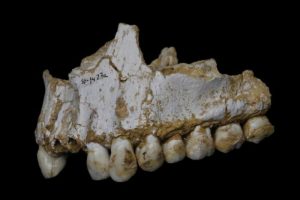 Speaking as we are on various types of humans in the evolutionary kaleidoscope here is a new Nature article on the latest research on Neanderthals — as read on ABC’s Science News:
Speaking as we are on various types of humans in the evolutionary kaleidoscope here is a new Nature article on the latest research on Neanderthals — as read on ABC’s Science News:
Ancient dental plaque shows some Neanderthals ate plants and used drugs
Mushrooms were part of their diet, and meat eating (e.g. eating woolly rhinoceros) followed vegetarianism, just like pre-Flood vegetarianism of the human race and post-Flood meat-eating (kidding — about the biblical Flood myth).
But I’m amazed at what we can learn …..
What’s more, DNA analysis of the dental plaque from the El Sidrón Neanderthal teenager showed he ate plants to treat illness.
The teenager, who had a dental abscess on his jaw and evidence of microbes that cause gastro intestinal illnesses such as diarrhoea and vomiting, ate poplar bark, which contains the active ingredient in aspirin, and Penicillium, the mould that produces penicillin.
“So it is likely he would have been trying to self-medicate,” said Dr Weyrich.
And in the midst of reading about how our technologies are being used to record our personal information and accessed for spying, it seems even geneticists can snoop on the private activities of long extinct Neanderthals:
Swapping spit with humans
Neanderthals and ancient and modern humans also shared a number of microbes that can cause dental and gum diseases — although Neanderthals did not have cavities or gum disease.
The team sequenced the draft genome of one gum disease microbe, Methanovrevibacter oralis, from the 48,000 year-old El Sidrón cave teenager.
“What we find is that it looks like [the microbe] was introduced from humans about 120,000 years ago, about the same time that humans and Neanderthals started interbreeding,” Dr Weyrich said.
She said this indicated interactions between Neanderthals and humans were much more intimate than previously thought.
Neil Godfrey
Latest posts by Neil Godfrey (see all)
- Questioning the Hellenistic Date for the Hebrew Bible: Circular Argument - 2024-04-25 09:18:40 GMT+0000
- Origin of the Cyrus-Messiah Myth - 2024-04-24 09:32:42 GMT+0000
- No Evidence Cyrus allowed the Jews to Return - 2024-04-22 03:59:17 GMT+0000
If you enjoyed this post, please consider donating to Vridar. Thanks!

If one accepts that hunter-gatherers represent our earliest human societies, then it looks like romantic kissing is a modern phenomenon.
What I find hilarious at that link is this gem: “In this regard, Jankowiak, et al. suspect that “Western ethnocentrism—that is “the belief that a behavior currently deemed pleasurable must be a human universal”—may be driving the common misconception that romantic–sexual kissing is a (near) universal.””
So he blames ethnocentrism for a perception in a multiethnic society. Brilliant. I think the real culprit to blame is Hollywoodcentricism.
There is only one instance of a romantic kiss in the Bible (Song of Solomon 1:2) and even it isn’t so clear that its anything like a modern kiss.
Much more intimate than interbreeding?
You noticed that too?
A bit of leaping going on here. The boy and his microbes are 48,000 years old and we leap to Neanderthals getting them from “humans” 120,000 years ago. Huh? These microbes probably come from the ancestral population of both and the relative presence or absence of them depends on the environment and diet of the hosts, as we see in the two Neanderthal populations discussed and as is already known of chimps; all three of us will eat meat, and hunt for it, if it is available. Both Neanderthalensis and Sapiens are human. There isn’t anything here we couldn’t work out from what we already know.